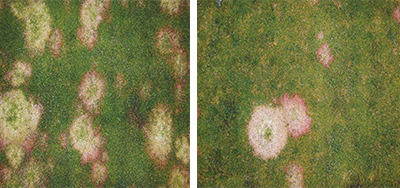Microdochium patch disease development

Effects of monthly urea applied fall through spring at 0.20 lb. N per 1,000 sq. ft. (left) versus the combination of 0.10 lb. N per 1,000 sq. ft. plus 0.10 lb. K per 1,000 sq. ft. (right). (Photos: Emily Braithwaite)
Microdochium patch (Microdochium nivale) can severely damage annual bluegrass turf when it’s cool and wet for long periods. This disease has been controlled with fungicides, but applications of urea to reduce wear from golfer traffic have been known to incite the disease. The purpose of this three-year experiment is to determine whether different rates of nitrogen and/or NPK combinations influence Microdochium patch disease levels on an annual bluegrass putting green.
Treatments were applied monthly from October 2017 through April 2018 on an annual bluegrass green (Bos Sod, Canada) built with 12 inches of sand meeting USGA guidelines on top of soil with drainage. Treatments were urea (46-0-0) at 0.10 and 0.20 lb. N/1,000 sq. ft.; 0.10 lb. K (potassium chloride) at both N rates; 0.025 lb. P (phosphoric acid)/1,000 sq. ft. at both N rates; and 0.025 lb. P plus 0.10 lb. K at both N rates.
In order to mitigate extremely high disease levels, elemental sulfur (0.25 lb. S/1,000 sq. ft./app) plus Duraphite (3.2 fl oz/1,000 sq. ft./app) was applied monthly October through April.
As expected, the high rate of nitrogen resulted in the most disease across all P and K levels (29 percent versus 19 percent). Also, as expected, plots treated with only nitrogen had the most disease (26 percent for the 0.10 N lb. rate and 36 percent for the 0.20 N lb. rate, respectively). Surprisingly, plots treated with N plus K had the least disease at both nitrogen levels (15 percent for the 0.10 lb. N rate and 22 percent for the 0.20 lb. N rate, respectively). This trial is funded by the USGA and the GCSAA.
Brian McDonald and Emily Braithwaite are research assistants, Alec Kowalewski, Ph.D., is a turfgrass scientist and Clint Mattox is a Ph.D. student at Oregon State University. You may reach Brian at
brian.mcdonald@oregonstate.edu for more information.










